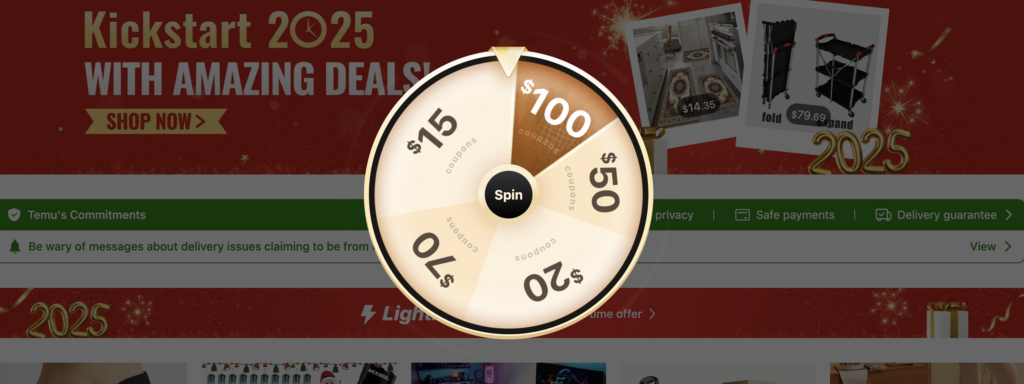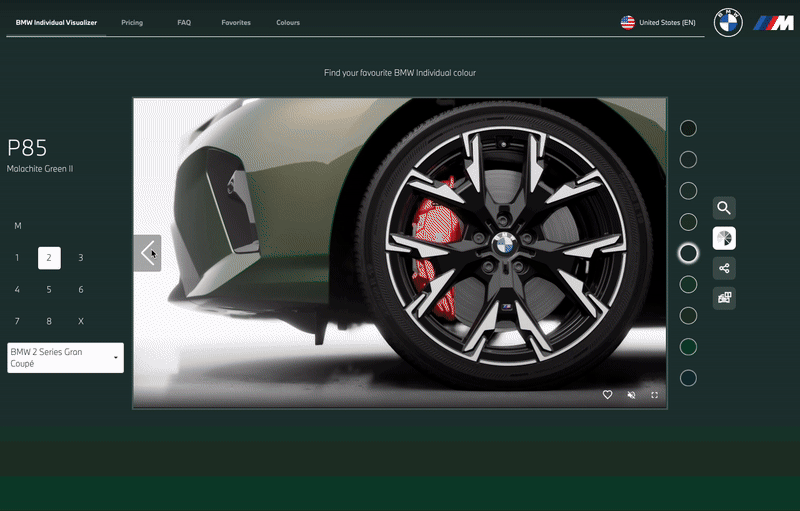
eCommerce Trends for 2025
The eCommerce landscape is constantly changing due to new innovations and shifting consumer priorities. As technology advances and customer expectations grow, eCommerce businesses must embrace key trends and transformative strategies to stay competitive.
With global eCommerce sales projected to reach $7.4 trillion this year, finding ways to harness new technologies and better engage with customers is crucial to claiming your slice of that pie.
In this article, we’ll explore some of these trends to uncover how they are poised to affect eCommerce in 2025 and beyond. We’ll touch on everything from already-popular strategies you may want to explore in the new year to brand-new ideas that can reshape your entire approach to online selling.
As you look ahead to the new year, these trends can create new opportunities for your business to drive growth, improve customer satisfaction, and stay ahead of an increasingly dynamic digital marketplace.

Gamified shopping experiences
Gamification adds excitement and interactivity to the eCommerce journey by integrating game-like elements—such as challenges, rewards, and competitions—into the shopping experience. This strategy not only entertains customers but also motivates them to explore, make purchases, and return to your site, fostering engagement and loyalty.
Some effective strategies for gamifying your digital storefront include:
- Reward programs: Plugins like myCred or Gratisfaction allow you to set up point-based systems where customers earn rewards for actions like purchases, reviews, or social shares.
- Spin-the-wheel promotions: Tools like OptinMonster can help you offer discounts, free shipping, or other perks with interactive “spin-to-win” wheels.
- Customer badges and achievements: Plugins like GamiPress make it easy to award badges for customer milestones like the frequency of their purchases, number of referrals, or amount of reviews.
- Quizzes and challenges: Tools like Quiz and Survey Master can create product recommendation quizzes or fun challenges that align with your brand and offerings.
- QR codes on ads and physical products: QR codes on ads or product packaging can direct customers to mini-games on your site. Once there, these games can enhance customer connection with your brand and provide additional rewards or discounts, increasing both engagement and conversions.
Gamification enhances the customer experience by adding some excitement and whimsy, which can increase time spent on the site and foster emotional connections with the brand. It incentivizes desired behaviors like making purchases, signing up for newsletters, or sharing content on social media.
For example, when KFC Japan added a new shrimp item to its menu, it launched a “Shrimp Attack” game, rewarding players with a discount voucher they could use to make a purchase in-store. 22% of the individuals who played the game actually used their voucher to make a purchase—an impressive conversion rate—and KFC Japan had to close the game halfway through its originally projected duration due to product shortages.
The psychological reward of earning points, unlocking perks, or achieving milestones creates a sense of progress and satisfaction, encouraging repeat visits and purchases. Additionally, gamification builds brand loyalty, as customers are more likely to engage with and return to sites offering an enjoyable and rewarding experience.
By capturing attention and fostering interaction, gamification can significantly increase conversions and customer lifetime value.

Visual and auditory micro-interactions
Micro-interactions are small, deliberate responses—both visual and auditory—to user actions on a website.
Whether a cart icon animates when an item is added or a subtle “ding” sound signals a completed purchase, each of these interactions enhances the sensory experience of your site to reinforce engagement as you guide users through the buying journey.
Some effective strategies for implementing micro-interactions include:
- Highlighting key elements: Add effects on buttons or simple animations to icons to reinforce the importance of a user’s click. You can use tools like WowStore to add these dynamic elements. Animation libraries like Animate.css can also provide a variety of simple animations without the additional weight that comes with extensive scripts.
- Audio cues: Incorporate subtle sound cues for significant actions, like a chime when items are added to a cart or a “ka-ching” after receiving payment. Plugins like WP Soundify or Hover Sounds can help you implement audio effects.
- Interactive navigation: Using tools like Elementor Pro, you can add animations to dropdown menus or clickable elements, creating a more dynamic experience.
- Loading indicators: Providing animated loaders with a plugin like Page Loader or implementing sound effects during page transitions can reassure users that their request is processing.
These enhancements improve user experience by making interactions feel smooth, polished, responsive, and engaging. Visual micro-interactions guide users intuitively through your buyer journey, reducing confusion and drop-offs, while sound cues create a multi-sensory connection that reinforces important actions like purchases and sign-ups.
By celebrating small milestones, micro-interactions build trust and satisfaction and make shopping experiences more memorable and enjoyable, increasing the likelihood of repeat visits.

Predictions and personalizations by AI
Artificial intelligence continues to revolutionize eCommerce, transforming customer experiences through data-driven personalization. By analyzing browsing history, purchase trends, and user interactions, AI can predict customer behavior and deliver tailored experiences that resonate with individual preferences.
For example, AI can suggest products, curate marketing messages, and adapt site content based on a customer’s previous purchases or browsing habits. This reduces friction, enhances product relevance, and fosters loyalty.
Chatbots can provide product suggestions and instant support, answering customer queries and minimizing the need for human intervention in customer service.
Tools like WP Engine’s Smart Search AI provide a natural-language search experience with typo tolerance to refine results, helping users find what they need quickly and improving overall site usability.
AI-powered personalization creates a more engaging shopping journey by delivering highly relevant content and reducing decision fatigue. Features like dynamic product recommendations open opportunities for upselling and cross-selling, while AI-driven search tools and chatbots minimize frustration and boost satisfaction.
By leveraging AI, eCommerce businesses can offer more seamless digital experiences that increase customer satisfaction, drive conversions, and promote long-term loyalty.

Streamlined navigation paired with powerful site search is essential for eCommerce success in the modern age. These features simplify the shopping experience, helping customers find products quickly and intuitively to reduce bounce rates and increase conversions.
To streamline your navigation, focus on essential categories and minimize visual clutter. Use dropdown menus sparingly, or implement “mega menus” for larger inventories to group items into clear categories and subcategories.
Breadcrumb navigation can also help users track their location within the site and easily backtrack, enhancing their browsing experience. Sticky headers that remain visible during scrolling (on both mobile and desktop devices), will ensure your users have consistent access to menus and can always find their way back to your home page.
Implement a robust search tool like Ajax Search Lite or WP Engine’s Smart Search AI to improve your site’s search experience. Features like typo tolerance and filtering options will help your shoppers locate products faster.
You can use predictive search to display results as users type, saving time and reducing frustration. Additionally, integrating voice search capabilities caters to the growing number of users relying on voice-activated technology to make purchases.
Minimalist navigation will keep your users focused on your products without overwhelming them, while advanced search capabilities ensure they can find specific items effortlessly. Together, these features create a seamless, intuitive user experience that builds trust, reduces friction, and encourages purchases.

Voice-activated shopping
Voice search allows users to find products or information using voice commands, often through virtual assistants like Alexa, Google Assistant, or Siri. Voice-activated shopping takes this one step further, enabling customers to complete transactions directly using voice commands.
It has become a valuable tool in digital commerce by simplifying and accelerating the shopping process, particularly for mobile and smart home users. This technology is particularly effective for impulse purchases, where speed and convenience are crucial to driving conversions.
To implement voice-activated shopping effectively, start by optimizing your site for voice search. Voice queries are often conversational and question-based, so incorporating natural language keywords and structured data can improve discoverability. Additionally, integrating with key platforms like Amazon Alexa Skills can enable direct transactions, making the purchasing process seamless for users.
A secure and streamlined checkout process is essential, with pre-stored payment and shipping details allowing for quick order confirmations to reduce friction.
Thorough testing and refinement of the voice purchasing system are critical to ensure accurate command recognition, seamless transaction processing, and a smooth user experience overall.
Voice-activated shopping simplifies user experiences by meeting the modern consumer’s demand for convenience and speed. By adopting this technology, eCommerce businesses can improve engagement, enhance customer loyalty, and increase conversions.

Zero-party data acquisition
Zero-party data refers to information that customers intentionally and proactively share with a business. Unlike first-party data, which is collected indirectly through user interactions, zero-party data is explicitly provided by customers in some way, such as through surveys, quizzes, or preference settings.
Because this data is provided voluntarily, it tends to be highly accurate, making it ideal for creating personalized customer experiences and targeted marketing campaigns. Plus, the information automatically complies with privacy laws like GDPR and CCPA because it’s provided voluntarily instead of being “collected” by traditional methods.
WordPress eCommerce store owners can accrue zero-party data through strategies that encourage user interaction.
Interactive quizzes and surveys, built with plugins like WPForms, are excellent tools for learning about customer preferences and needs. For subscription or membership-based businesses, plugins like Ultimate Member enable customers to directly share information that informs more personalized experiences. Post-purchase feedback requests via email or on order confirmation pages provide further opportunities to gather actionable zero-party insights.
Focusing on customer preferences helps businesses build stronger relationships and encourage long-term loyalty. The accuracy of zero-party data also enables more targeted marketing campaigns, cutting wasted ad spend and improving ROI.
By integrating zero-party data into their strategies, WordPress eCommerce store owners can enhance customer trust, drive engagement, and achieve higher conversion rates while staying ahead in an increasingly privacy-focused digital landscape.

Hyperlocal eCommerce
Hyperlocal eCommerce focuses on catering to customers in specific geographic areas, offering products, services, or experiences tailored to local preferences. This strategy enhances relevance and convenience by leveraging proximity and often includes features like local or same-day delivery, curbside pickup, and personalized marketing campaigns targeting specific neighborhoods or communities.
Hyperlocal strategies help bridge the gap between online and offline shopping, fostering trust and familiarity with nearby customers. By creating tailored experiences that feel personal and local, businesses can strengthen their connections in key markets.
WordPress eCommerce store owners can implement a few key strategies to make their stores hyperlocal.
Geolocation tools like GeoTargeting WP allow your site to dynamically display region-specific products, services, and shipping options. Optimizing for hyperlocal SEO is essential—plugins like Yoast SEO can help you target niche keywords for specific neighborhoods or business districts, optimize structured data for local businesses, and ensure accurate listings on platforms like Google My Business.
For stores offering local pickup or delivery, plugins like this one by MultiDots make it easy to manage curbside pickup or customize delivery zones to meet specific needs.
Incorporating hyperlocal marketing tactics, such as targeted email campaigns and localized digital ads, can further increase your reach. Running “coming soon” or “now open” campaigns in new market areas and offering digital coupons that are redeemable in-store are effective ways to engage customers in a hyper-localized area.
The key to a successful hyperlocal eCommerce strategy is emphasizing convenience and immediacy. Offering same-day delivery or pickup can quickly increase conversion rates by reducing barriers like shipping delays. Additionally, strategies like geo-targeted advertising and local promotions help you gain a foothold in new market segments, establishing your brand as a trusted, community-centric presence.
By adopting a hyperlocal approach, WordPress eCommerce stores can create more meaningful connections with local customers, boosting trust and driving growth.

AR-powered shopping
AR-powered shopping uses augmented reality (AR) to create an interactive experience, allowing customers to visualize products in their real-world environments. This technology helps bridge the gap between online and in-store shopping by letting customers see how a product would fit into their lives, increasing confidence in their pre-purchase decision-making.
AR is particularly beneficial for retailers selling personal items like clothes and makeup, larger products like furniture, and products that are difficult to conceptualize like home paint colors. By offering an immersive, personalized shopping experience, AR reduces uncertainty and builds trust before customers commit to a purchase.
To incorporate AR into your eCommerce strategy, start by selecting the right AR tools for your store. WordPress plugins like CartMagician PRO and AR for WordPress can help you integrate AR features seamlessly.
Once integrated, focus on creating accurate, high-quality 3D models of your products. Promote your AR features in marketing campaigns and offer tutorials to guide customers in using the tool effectively.
AR-powered shopping enhances engagement, reduces returns by boosting confidence, and provides a unique, memorable experience that can help set brands apart in a competitive market.

Subscription selling
Subscription selling is a thriving business model where customers receive products or services on a recurring basis. Popular in industries like beauty (e.g., Ipsy), food (e.g., Thrive Market), home goods (e.g., FilterEasy), and software (e.g., Spotify), this model offers predictable revenue streams and strengthens customer loyalty by delivering convenience and value.
To effectively implement subscription selling, eCommerce store owners should focus on convenience. Offer subscriptions for consumables like coffee or skincare, or create exclusive experiences such as monthly curated boxes with surprise items. Providing flexibility is essential—tiered subscription plans can accommodate various budgets and preferences, while easy cancellation and modification options build trust and lower entry barriers.
Highlight subscription options on your product pages, emphasizing the benefits of subscribing. Clearly communicate your value proposition—whether it’s cost savings, exclusivity, or convenience—and feature it prominently in marketing campaigns.
Simplify your onboarding process by offering user-friendly interfaces and clear instructions. Since many customers subscribe for convenience, the sign-up process should be straightforward. Incentives such as free trials or discounts on the first order can also encourage sign-ups.
Personalization plays a key role in retaining subscribers. Use customer data to offer tailored product recommendations and surprise items, and reward loyalty with perks like discounts, early product access, or exclusive content. Clear communication about billing and shipping schedules ensures a smooth customer experience to keep cancellations low.
Subscription selling boosts customer retention and lifetime value, provides a steady revenue stream, and strengthens brand loyalty, making it a powerful strategy for long-term eCommerce growth.

Live shopping
Live shopping combines live streaming with eCommerce, allowing brands to showcase products and interact with viewers in real time. This approach drives engagement, creates urgency, increases brand exposure, and builds trust by transparently demonstrating products.
To make live shopping effective, engage your audience by answering chat questions, highlighting key product features, and encouraging real-time interactions. Partnering with influencers who resonate with your target audience can expand your reach and credibility, while interactive elements like polls and Q&A sessions keep viewers engaged.
Choose a live shopping host who can share practical use cases that show how products solve problems or fit into customers’ lives. Additionally, creating a sense of urgency with limited-time offers or exclusive products can drive impulse purchases.
Start by finding the right platform for your live shopping experiences, such as Instagram Live, Facebook Live, or TikTok Live, and integrate it with your eCommerce store. Then, promote upcoming sessions through email, social media, and website banners to build excitement.
During the live session, ensure high-quality video production with good lighting and clear audio for an optimal viewing experience. After the event, you can repurpose the content for social media or on your site to extend its impact.
Live shopping blends entertainment with commerce, providing a dynamic, interactive shopping experience that enhances customer engagement and boosts conversions.

Payment processing: Options, options, and more options
To cater to a wide range of customers, eCommerce stores should accept multiple forms of payment. These can include:
- Credit and debit cards: The most common and trusted forms of payment, these are essential for any online store.
- Digital wallets: Services like PayPal, Apple Pay, and Google Wallet provide convenience and security for quick checkouts.
- Buy Now, Pay Later (BNPL): Providers like Klarna, Afterpay, and Affirm allow customers to make payments in installments, which may be appealing to budget-conscious shoppers.
- Bank transfers: For large-ticket purchases, bank transfers may be preferable for customers who want to avoid the additional fees that often come with credit card processing.
- Cryptocurrency: While this may not be useful to a wide audience, accepting different forms of cryptocurrency like Bitcoin or Ethereum can attract tech-savvy customers. If your products already align with this market segment, it may be wise to consider accepting cryptocurrency.
- Local Payment Methods: Tailor options to include payment methods commonly used by your target market, such as Alipay in China or UPI in India.
Offering a variety of payment methods reduces friction at checkout and minimizes cart abandonment by catering to customers’ preferred payment options. BNPL services, for example, can boost average order values by making higher-ticket items more accessible. Digital wallets and one-click payments streamline the checkout process to provide convenience, especially for mobile shoppers looking for quick purchases.
By meeting diverse payment preferences, stores build trust, create a smoother shopping experience, and drive higher conversions.

Mobile-focused omnichannel shopping experiences
With U.S. mobile commerce sales exceeding $338 billion and 187.5 million mobile shoppers, prioritizing mobile-optimized, omnichannel strategies is crucial for eCommerce success. A seamless, well-designed digital experience across all customer touchpoints is no longer optional—it’s essential.
For WordPress store owners, mobile optimization begins with responsive design, which adapts content to different screen sizes. It also involves compressing images and large files to reduce load times, using caching for better performance, and simplifying navigation for easier use.
A mobile-friendly site also boosts SEO performance, as search engines reward sites that provide a smooth, engaging experience. However, optimizing your website means nothing if the rest of your digital strategy isn’t focused on driving traffic back to it. Extend this mobile-first approach to all customer touchpoints, including social media, email campaigns, app notifications, digital ads, and customer support, with all roads leading back to your shop.
Ensuring consistency across all digital channels builds brand trust and enhances customer retention. By focusing on responsive design, fast performance, and cohesive messaging across all digital platforms, you can maximize the impact of your omnichannel strategy.

Sustainable products, packaging, and shipping
Sustainable products are designed to minimize environmental impact through eco-friendly materials and ethical production methods. They often use recyclable, biodegradable, or reusable materials to reduce waste, aiming for a minimal or even carbon-neutral footprint.
For eCommerce retailers, adopting sustainable shipping methods, such as carbon-neutral deliveries, can reduce ecological impacts. Consumer preference for sustainability is growing, with 72% of online shoppers valuing sustainable packaging. Brands that embrace these practices report higher customer satisfaction, particularly among Millennials and Gen Z, a large subsection of consumers that prioritize sustainability when making purchasing decisions.
Retailers can implement sustainable practices in several ways. Choosing recyclable, biodegradable, or reusable packaging is an easy first step. Many companies offer packaging solutions that align with these principles while maintaining a brand’s image.
Partnering with carriers that offer carbon-neutral shipping or eco-friendly delivery options is another effective strategy. While achieving a zero-carbon operation may not be feasible for every business, transparency in product sourcing, production, and shipping builds trust with environmentally conscious consumers.
Additionally, optimizing website performance to reduce energy consumption contributes to your sustainability efforts.
By adopting sustainable practices, eCommerce businesses can meet the increasing demand for eco-friendly options, enhance brand reputation, and drive customer loyalty, ultimately boosting conversions and repeat business.
Set a resolution for eCommerce success with WP Engine
As we head into 2025, staying ahead of emerging trends is essential to meeting the evolving demands of consumers. By embracing strategies like gamified shopping, AI-driven personalization, mobile optimization, and zero-party data acquisition, businesses can drive engagement, foster loyalty, and boost conversions.
Adapting to these trends both enhances the experiences of your customers and positions your brand for long-term growth.
If you’re ready to take your eCommerce store to the next level, WP Engine’s eCommerce hosting plans are designed to provide the speed, security, and scalability needed by retailers using WordPress.
Explore our hosting solutions or speak with a representative now to unlock the full potential of your eCommerce experience.












